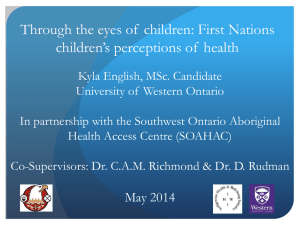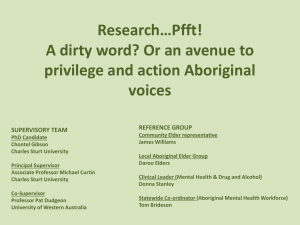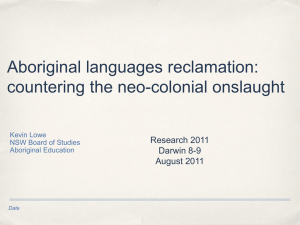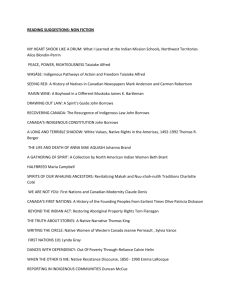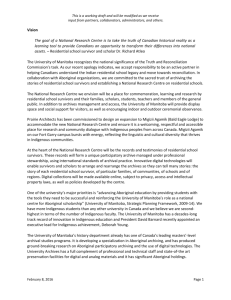Sixties Scoop - East Northumberland Secondary School
advertisement
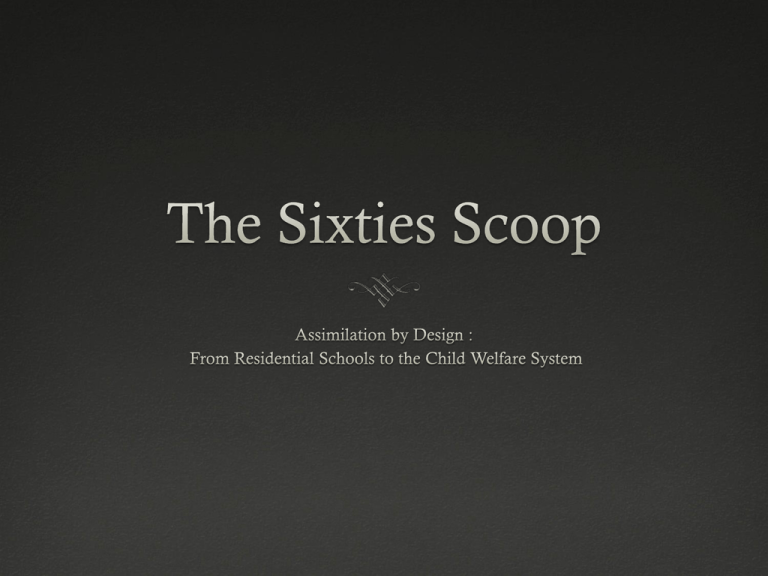
Policy of Assimilation “A deliberate policy to separate and forcibly assimilate Aboriginal First Nations children into the mainstream has pervaded every era of Aboriginal history in Canada. Each era saw a new reason to take Aboriginal children away from their homes, placing them in residential schools, foster care, or non-Aboriginal adoptive families.” – Suzanne Fournier New Methods, Same Means The 60s Scoop refers to the adoption of First Nation children in Canada between the years of 1960 and the mid 1980’s. In many instances, children were literally scooped from their homes and communities without the knowledge or consent of families and bands. Many First Nations stated that in many cases, where consent was not given, that government authorities and social workers acted under the colonialistic assumption that Indigenous people were culturally inferior and unable to adequately provide for the needs of the children. “Best Interest of the Child” Gradually, as education ceased to function as the institutional agent of colonization, the child welfare system took its place. It could continue to remove Indigenous children from their parents, devalue Indigenous custom and traditions in the process, but still act “in the best interests of the child.” Those who hold to this view argue that the Sixties Scoop was not coincidental; it was a consequence of fewer Indigenous children being sent to residential school and of the child welfare system emerging as the new method of colonization. Changing Ideas of Assimilation In the early 1960’s, social service agencies and government departments began shifting their focus on the assimilation process of Aboriginal children. The federal and provincial governments’ decided that it would make more ‘financial sense’ to remove children from their communities and place them in individual homes across Canada and the United States instead of Residential Schools. Basis for Removal Agencies deemed Aboriginal parents as ‘neglectful’ and this was the main basis for removal. ‘Neglect’ covered a wide spectrum within the Child Welfare system, alcoholism, drug abuse, being a single parent and living in poverty were all grounds for removal. ‘Neglectful’ home circumstances were often economic, the product not of some flaw in the character of Aboriginal parents but if the marginalization of Aboriginal communities. The Numbers Statistics from the Department of Indian Affairs reveal a total of 11,132 status Indian children adopted between the years of 1960 and 1990. It is believed, however, that the actual numbers are much higher than that. While Indian Affairs recorded adoptions of ‘status’ native children, many native children were not recorded as ‘status’ in adoption or foster care records. Of these children who were adopted, 70% were adopted into nonnative homes. More recently, it has been estimated that over 20,000 aboriginal children were taken from their families and fostered or adopted out to primary white middle-class families. Today Aboriginal peoples in Canada currently have the fasting growing population. Aboriginal peoples in Canada also have the youngest median age, averaging around 24. Currently, there are more Aboriginal children in the Child Welfare system than at the height of the Residential School era or during the Sixties Scoop. Perspectives on Child Welfare: APTN http://aptn.ca/pages/news/2010/11/16/perspectiveson-child-welfare-60s-scoop/ The Current on CBC: The Sixties Scoop http://www.cbc.ca/thecurrent/episode/2011/06/24/t he-sixties-scoop/ First Nations Child and Family Caring Society of Canada http://www.youtube.com/embed/jZE7YASM6ts Discussion What are some of the parallels between the Residential School experience and the Sixties Scoop? Do you believe that it was the Canadian government's agenda to continue the assimilation process of Indigenous children, or did they genuinely have the best interest of the children at heart? In what ways can this situation and past injustices be reconciled?




